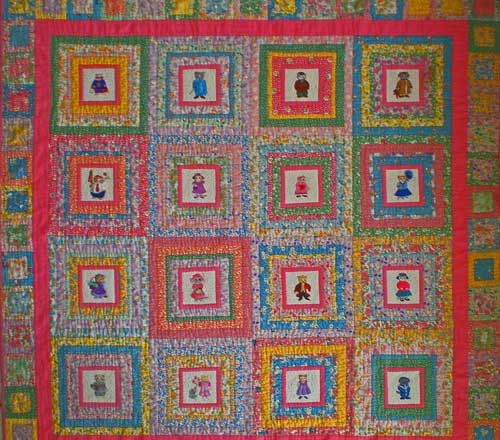This post contains affiliate links for which I receive compensation
Using batting as a stabilizer under machine embroidered squares for quilt
by Lori
(Reno)
Lori writes...
I am new to machine embroidery and quilting.I want to do a quilt that alternates blocks with a machine embroidered design on them with blocks that will have machine quilting on them. It was suggested to me to use Floriani Batting as my stabilizer under the embroidered blocks. What do you think of this idea?
Would I then use a batting to cover/sandwich the whole quilt? I am confused, any help or ideas would be greatly appreciated!
Julie replies...
Hi Lori! What a wonderful way to showcase your machine embroidery designs! I love it!What's worked for me with high stitch-count embroideries...
I stablized the fabric with a woven tricot fusible interfacing, crossing the lengthwise grainlines. Once the interfacing is fused to the back of the fabric, the fabrics LW grain goes top to bottom and the LW grainline of the tricot fusible goes side to side. The provides a very stable fabric to embroider on. The fusible was just a smidge smaller than the oversized square of fabric—that way I didn't gunk up my iron.After embroidering, the quilt block is cut to size and stitched into the quilt top. It it then layered with backing and batting, basted and machine quilted.
The 'Kitty' quilt was the result. I've made several of these types of quilts—they make a nice baby quilt to gift.

What you'll need to consider...
I'm assuming that the embroidered blocks are the 'stars' of your planned quilt. You'll want to give them more emphasis with either brighter or higher contrast threads and machine quilting that complements their design.- Heavily quilted areas will visually recede. That why quilters put a lot of background quilting behind applique. The applique visually 'lifts up' from the background.
If your embroidery designs are high-stitch count like the Kitties, and you planned to put very little quilting around them in the same block, your background could literally end up higher than the embroidery with the batting as stabilizer. Those high stitch-counts compact the batting more than the quilting. Sandwiching with another layer does nothing to improve the situation. - Low-stitch count designs resemble machine quilting. Putting batting behind them as a stabilizer gives them more emphasis than the machine quilted blocks. (They're visually closer because the batting isn't as compressed as the first option.)
The only way I would consider this option, though, is if the machine quilting in the alternate blocks is:- Very simple, like grid quilting with a walking foot
- High contrast with the embroidered blocks, i.e. if the embroidery is curvy, then grid quilting for sure.
Not knowing what the designs are like makes it hard to give a definitive answer.
A stitch in time, saves nine...
Make a sample stitch out.If you're uncertain as to what to expect, this is the best recommendation. You'll know for sure if you like the finished quilt before it's finished.
I'd do a sew-out of the embroidery, piece it to the alternate block and then quilt the whole thing. If the finished quilt will be used on a bed, lay the sample horizontally; if it's meant for a wall, then vertically. Live with it for a few days.
Then make your decision.
This sounds like a lot of work.
You're right!
It IS extra work.
But you'll spend a considerable amount of time between the embroidery and quilting. Getting it right for you is well worth the effort!
I hope this has helped in your decision making. Your own eyes will tell you what you like best. Depend can depend on them.
Readers, your comments and suggestions are appreciated. Just use the comments link below to share.
Thank you.
Piecefully,
Julie Baird
Editor
Comments for Using batting as a stabilizer under machine embroidered squares for quilt
|
||
|
||
|
||
|
||














